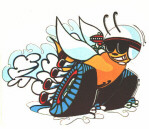The Junkyard Guides will cover a variety of topics that you will want to be aware of at junkyards and swap meets. Future topics will cover such items as engine blocks, cylinder heads, radiators, transmissions and carburetors. The first installment in our Junkyard Guide will cover rear axles:
The easiest way to identify an axle is to look at the cover on the carrier housing:
7-1/4.....9-bolt rear cover.
8-1/4.....10-bolts, evenly spaced, cover is almost perfectly round.
8-3/4.....No rear cover, round.
9-1/4.....12-bolt rear cover.
9-3/4.....10-bolt rear cover, cover has about 6 uneven straight edges.
Or, you can crawl under the car to have a look at the casting number. The following is an incomplete list of common casting numbers you will find in many junkyards. The casting number is usually found on the front right or bottom of the carrier housing.
7-1/4
- 2070051
- 3507881
- 3723675
8-1/4
- 2852905
- 3723598
- 3723599
8-3/4
- 1820657 (small stem, up to 1964)
- 2070741 (small stem, 1965 to about 1972)
- 2070742 (large stem, 1957 to 1968)
- 2881489 (tapered pinion, 1969 to about 1974)
9-1/4
- 3507890
- 3507891
- 3723199
All of the above axles were available with SureGrip, which is a limited-slip unit. SureGrip is a desirable option in any axle. If you have the choice between a Sure-Grip or a non-SureGrip axle, choose the SureGrip. To identify a SureGrip axle, jack up the back end of the car and turn one wheel. If the opposite wheel turns in the same direction, a SureGrip unit is present and operational. If the opposite wheel does not turn, or if it turns in the opposite direction, it is an "open" or "peg-leg" axle or does not have an operational SureGrip unit. Don't forget to check the axles in trucks and vans, including A100s and A108s.
440 and Street Hemi cars with a 4-speed should have the 9-3/4 axle, which was manufactured by Dana and is known as a Dana 60. The Dana 60 is the most desirable and most expensive axle for Mopars. The Dana 60 came in two lengths. The 54.9" axle came in '66-'70 B-bodies, the 56.5" axle came in '70-'71 E-bodies and '71 B-bodies. These two axles are not interchangeable without modification, so try to stick with the correct length for your car if you install a Dana 60. The Dana 60 was installed in some '72 passenger vehicles and could have been retrofitted in almost anything. It was also optional in cars without a 440 or Street Hemi and in automatic transmission cars. If you find a Dana 60 in a junkyard, you might want to buy it! There were two SureGrip units in the Dana 60. From '66 to '69 it was called Power-Lok, from '70 on it was called Trac-Loc. Power-Lok is more desirable for racing. The two SureGrip units are interchangeable.
The 8-3/4 axle is common in many Mopars, including performance cars. It was not available on 440 or Street Hemi cars with a manual transmission. A-body cars up to '72 that had an 8-3/4 will have a small bolt-pattern hub and will require using small bolt-pattern wheels. Small bolt-pattern hubs measure 4" between alternate wheel studs as opposed to 4.5" on B, C, E and later A-body cars. It can be argued that all A-body 8-3/4 axles are small bolt-pattern, as the A-body 8-3/4 was built until '72 or so. In any event, be aware that there are two different bolt patterns in an 8-3/4.
To make a fairly educated guess as to the gear ratio installed in a junkyard axle, mark one of the rear tires or hubs at the 12:00 position, then mark the driveshaft or yoke where you can see it while you're not under the car. Jack up the back end of the car so that the rear wheels are off the ground and turn the rear wheel that you marked one full revolution. The axle ratio will be [the number of turns the diveshaft made] : [the number of turns the wheel made]. Since you're turning the wheel once, twelve o'clock to twelve o'clock, your answer will always be a [something]:1 ratio. If the driveshaft turns 3-1/2 times, the ratio is roughly 3.5:1 and you likely have a 3.54:1 or 3.55:1 gear. If the driveshaft turns 3-1/4 times, you probably have a 3.23 gear, 2-3/4 is roughly 2.76, slightly less than 4 turns is roughly 3.91, slightly more than 4 turns is roughly 4.10 and so on.
